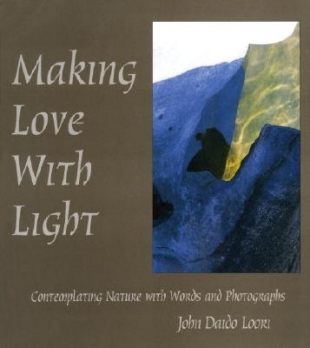"Minor White, my photography teacher, once said to a group of us at a workshop, 'Try to photograph using light in such a way that it expresses a warm emotional feeling for some thing, some person, some place that is not necessarily the subject being photographed.' He said, 'I can photograph a plow, and if the light is right I'm making love — but not to the plow. If I give the photograph to someone I'm giving them a gift of love. Try to be aware of the light,' he said. 'Try to bring it into the photograph in some way. If you make a portrait, let the light show that the person is not only lovable, but edible. Or make a photograph that has a sense of love in it which you can give to someone as a gift.'
"That assignment was the beginning of a very powerful three-decade long romance with light that has immeasurably enriched my art and my life. I am certain that I will never exhaust the possibilities of 'making love with light.'
"We are all constantly in the midst of light. We are surrounded, bathed, and nourished by it. This miracle we call light can transform. It can teach, reveal, evoke, and heal. It speaks in many voices. We tend to see light as something that makes form visible, but light reveals much more. It reveals us. In the subtle, soft undulations of a snowscape illuminated by an overcast sky, in the raw presence of a backlighted, towering, ancient oak, both subject and photographer are revealed. Light makes visible the invisible. It can show us love where there seems to be only a rotting log or a solitary rock perched on a ledge. Sometimes the subject is illuminated by light, sometimes the subject is illumination itself. Then the subject itself glows; there are no shadows.
"Light has the ability to reveal the many layers, the myriad faces contained in each form. Most often, we tend to see just the surface of a subject. We name it, identify it, and forget about it. And we stop seeing. Yet when the light changes, the subject changes, and what the subject has to show us changes. Unless we are ready to be patient and sit with our subjects, allowing the light to transform them, we see little more than their superficial aspects, and our art and our lives reflect that shallowness. If we are patient, letting go of thoughts and letting the mind settle down, then the hidden faces rise to the surface, and subtlety and richness return. A shift takes place, resonance appears. This allows for real intimacy with the subject.
"Sometimes light is diffuse; the day is overcast and there is no localized light source. Everything is illuminated by the huge hemisphere of the sky and takes on a subdued, luminescent, and sensual character. Even craggy rocks become soft and delicate. When light becomes directional and there is a single, strong source of illumination texture appears. Different aspects of the same subject come into view. The boulder that was once very soft under diffuse lighting now becomes hard and heavier looking. When the subject reflects the light, the reflections add another dimension; patterns begin to appear. Before sunrise the world is essentially black and white. You can still see things and they can be photographed, but essentially there is no color. The light is cool, shadows not apparent. Things are almost translucent. Unless we are really 'seeing' and not just looking, it is easy to miss the richness of these subtleties."
